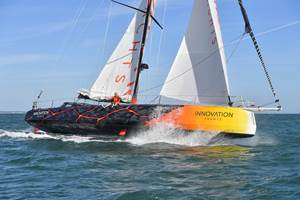IACMI and ORNL showcase additive manufacturing advancements at IMTS
Demonstration followed the journey of an additively manufactured metal die as it was 3D printed, machined and used to mold advanced composite parts.
The Institute for Advanced Composites Manufacturing Innovation (IACMI, Knoxville, TN, US) and the Department of Energy’s Oak Ridge National Laboratory (ORNL, Knoxville, TN, US) are partnering with key industry leaders to showcase significant advancements in materials and speeds for additive manufacturing at the 2018 International Manufacturing Technology Show (IMTS). Visitors can follow the journey of an additively manufactured metal die as it is 3D printed, machined and used to mold advanced composite parts, all in only a few hours on the exhibit floor.
The project, rightfully named “Die in a Day”, underscores the advantages of additive manufacturing, or 3D printing, to revitalize the fading US tool and die market and diminish fabrication time, which conventionally takes weeks or months, down to a matter of hours. Each day of the show will feature the molding of a different composite part, beginning with the 3D printing of an additively manufactured metal die, or mold, by a Lincoln Electric Additive System. The die will then be machined on a Mazak computer numerical control (CNC) system before finally being used by IACMI to fabricate parts on a Wabash MPI compression molding press. Throughout the week, the final parts will be scanned by Quality Vision International to ensure dimensional tolerances are met.
“Tooling touches nearly everything individuals interact with on a daily basis,” says Craig Blue, director of Energy Efficiency and Renewable Energy at ORNL. “The concept of producing a ‘Die in a Day’ not only represents the speed of additive manufacturing, but also how this technology can help revitalize the tool and die industry in the US and provide national capabilities to local ecosystems.”
IACMI and ORNL will also be showcasing prototypes from an innovative project that has successfully produced carbon fiber injection molded automotive fenders using ORNL’s textile-based carbon fiber (TCF). This novel, low-cost fiber was chopped and compounded with Techmer PM material for molding at the IACMI Scale-Up Research Facility (SURF) in Detroit, MI, US marking the first ever successful compounding and injection molding of a full-size automotive component with carbon fiber made from textile-grade PAN precursor. This fiber was first developed at the US Department of Energy’s Carbon Fiber Technology Facility (CFTF) in Oak Ridge, TN, US and was compounded into 10% carbon fiber pellets. Finally, the parts were injection molded using a 3,000-ton Milacron injection molding machine at the IACMI SURF, which is supported financially by Michigan Economic Development Corporation (MEDC), the US Department of Energy, and other private partners, and managed by Michigan State University (East Lansing, MI, US).
“The injection molded fenders represent a significant milestone in demonstrating the capability of the textile-based carbon fiber to serve the application needs for lightweight automotive parts at lower costs than previously possible,” says Merlin Theodore, the director of the CFTF and IACMI’s Materials and Processes Technology Area director.
Next steps to the project include injection molding with 40% TCF, a 50:50 blend of the 10% and 40% TCF, and TCF to yield a 25% final loading. Integrating carbon fiber into automotive exterior parts, such as fenders, offers an opportunity to transform the automotive industry by reducing the weight of automotive parts and environmental impact while increasing fuel efficiency.
“Advanced technologies are critical to manufacturing competitiveness,” says John Hopkins, IACMI CEO. “Through our public-private partnerships, IACMI is providing a production relevant environment for innovation in which these technologies can be developed and demonstrated at scale. Our projects allow industry to access a network of unique capabilities and talent that would not be possible without this type of collaboration.”
To learn more visit the two companies at 2018 IMTS: IACMI will be at Booth 338693, South Building, Level 3 and ORNL will be at Booth 431609, West Building, Level 3.
IACMI and ORNL will also be presenting at Carbon Fiber 2018. Learn more about the event at .
Related Content
Life cycle assessment in the composites industry
As companies strive to meet zero-emissions goals, evaluating a product’s carbon footprint is vital. Life cycle assessment (LCA) is one tool composites industry OEMs and Tier suppliers are using to move toward sustainability targets.
Read MorePartners recycle A350 composite production waste into adjustable-length rods for MFFD
Herone, Spiral RTC, Teijin Carbon Europe and Collins Aerospace Almere recycle A350 thermoplastic composite clips/cleats waste into rods for the all-thermoplastic composite Multifunctional Fuselage Demonstrator’s crown.
Read MoreEuropean boatbuilders lead quest to build recyclable composite boats
Marine industry constituents are looking to take composite use one step further with the production of tough and recyclable recreational boats. Some are using new infusible thermoplastic resins.
Read MorePlant tour: Hexagon Purus, Kassel, Germany
Fully automated, Industry 4.0 line for hydrogen pressure vessels advances efficiency and versatility in small footprint for next-gen, sustainable composites production.
Read MoreRead Next
Cutting 100 pounds, certification time for the X-59 nose cone
Swift Engineering used HyperX software to remove 100 pounds from 38-foot graphite/epoxy cored nose cone for X-59 supersonic aircraft.
Read MoreUltrasonic welding for in-space manufacturing of CFRTP
Agile Ultrasonics and NASA trial robotic-compatible carbon fiber-reinforced thermoplastic ultrasonic welding technology for space structures.
Read MoreScaling up, optimizing the flax fiber composite camper
Greenlander’s Sherpa RV cab, which is largely constructed from flax fiber/bio-epoxy sandwich panels, nears commercial production readiness and next-generation scale-up.
Read More












